Analysis of E-Commerce Business Model for Royal Bank of Scotland
VerifiedAdded on 2019/12/03
|11
|3028
|222
Report
AI Summary
This report provides an in-depth analysis of the e-commerce business model employed by the Royal Bank of Scotland (RBS). It begins with an introduction to RBS, its market share, and the rise of e-commerce within the banking industry, including the impact on online and mobile banking. The main body of the report delves into the eight key elements that guide an e-commerce business model, such as value proposition, revenue models, market opportunity, and competitive advantage. It then applies these elements to RBS, examining the bank's B2B and B2C models, with a focus on transaction broker models. The report further discusses the implementation of these models, including the transaction fee revenue model and how RBS can enhance its collaborations with customers. Finally, the report touches upon areas that RBS needs to address regarding ethical responsibilities and customer data security, concluding with a review of the findings and references.

E-COMMERCE
Paraphrase This Document
Need a fresh take? Get an instant paraphrase of this document with our AI Paraphraser
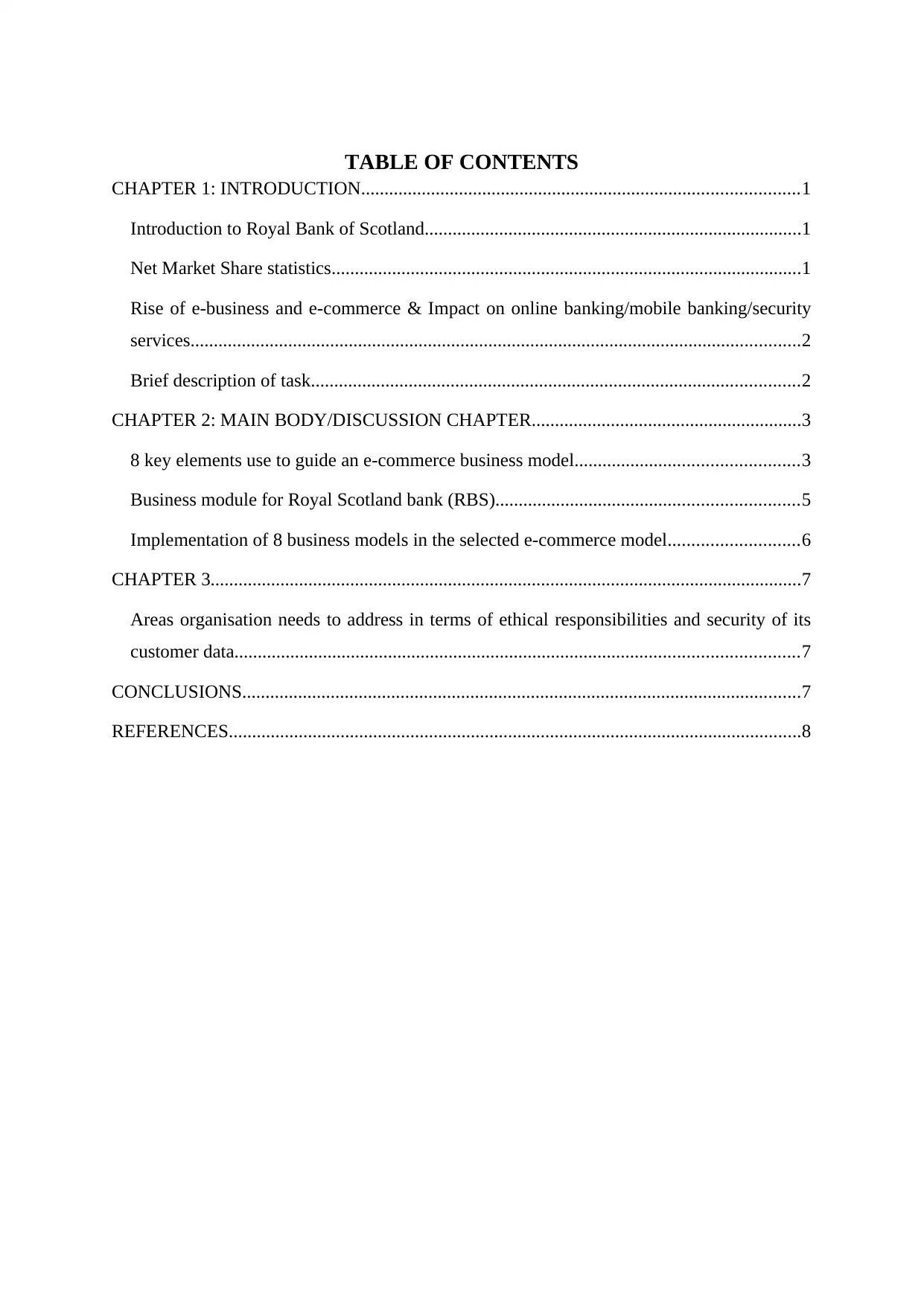
TABLE OF CONTENTS
CHAPTER 1: INTRODUCTION..............................................................................................1
Introduction to Royal Bank of Scotland.................................................................................1
Net Market Share statistics.....................................................................................................1
Rise of e-business and e-commerce & Impact on online banking/mobile banking/security
services...................................................................................................................................2
Brief description of task.........................................................................................................2
CHAPTER 2: MAIN BODY/DISCUSSION CHAPTER..........................................................3
8 key elements use to guide an e-commerce business model................................................3
Business module for Royal Scotland bank (RBS).................................................................5
Implementation of 8 business models in the selected e-commerce model............................6
CHAPTER 3...............................................................................................................................7
Areas organisation needs to address in terms of ethical responsibilities and security of its
customer data.........................................................................................................................7
CONCLUSIONS........................................................................................................................7
REFERENCES...........................................................................................................................8
CHAPTER 1: INTRODUCTION..............................................................................................1
Introduction to Royal Bank of Scotland.................................................................................1
Net Market Share statistics.....................................................................................................1
Rise of e-business and e-commerce & Impact on online banking/mobile banking/security
services...................................................................................................................................2
Brief description of task.........................................................................................................2
CHAPTER 2: MAIN BODY/DISCUSSION CHAPTER..........................................................3
8 key elements use to guide an e-commerce business model................................................3
Business module for Royal Scotland bank (RBS).................................................................5
Implementation of 8 business models in the selected e-commerce model............................6
CHAPTER 3...............................................................................................................................7
Areas organisation needs to address in terms of ethical responsibilities and security of its
customer data.........................................................................................................................7
CONCLUSIONS........................................................................................................................7
REFERENCES...........................................................................................................................8

LIST OF FIGURES
Figure 1Account market share of UK industry..........................................................................1
Figure 2B2B vs. B2C E-Commerce...........................................................................................5
Figure 1Account market share of UK industry..........................................................................1
Figure 2B2B vs. B2C E-Commerce...........................................................................................5
⊘ This is a preview!⊘
Do you want full access?
Subscribe today to unlock all pages.

Trusted by 1+ million students worldwide
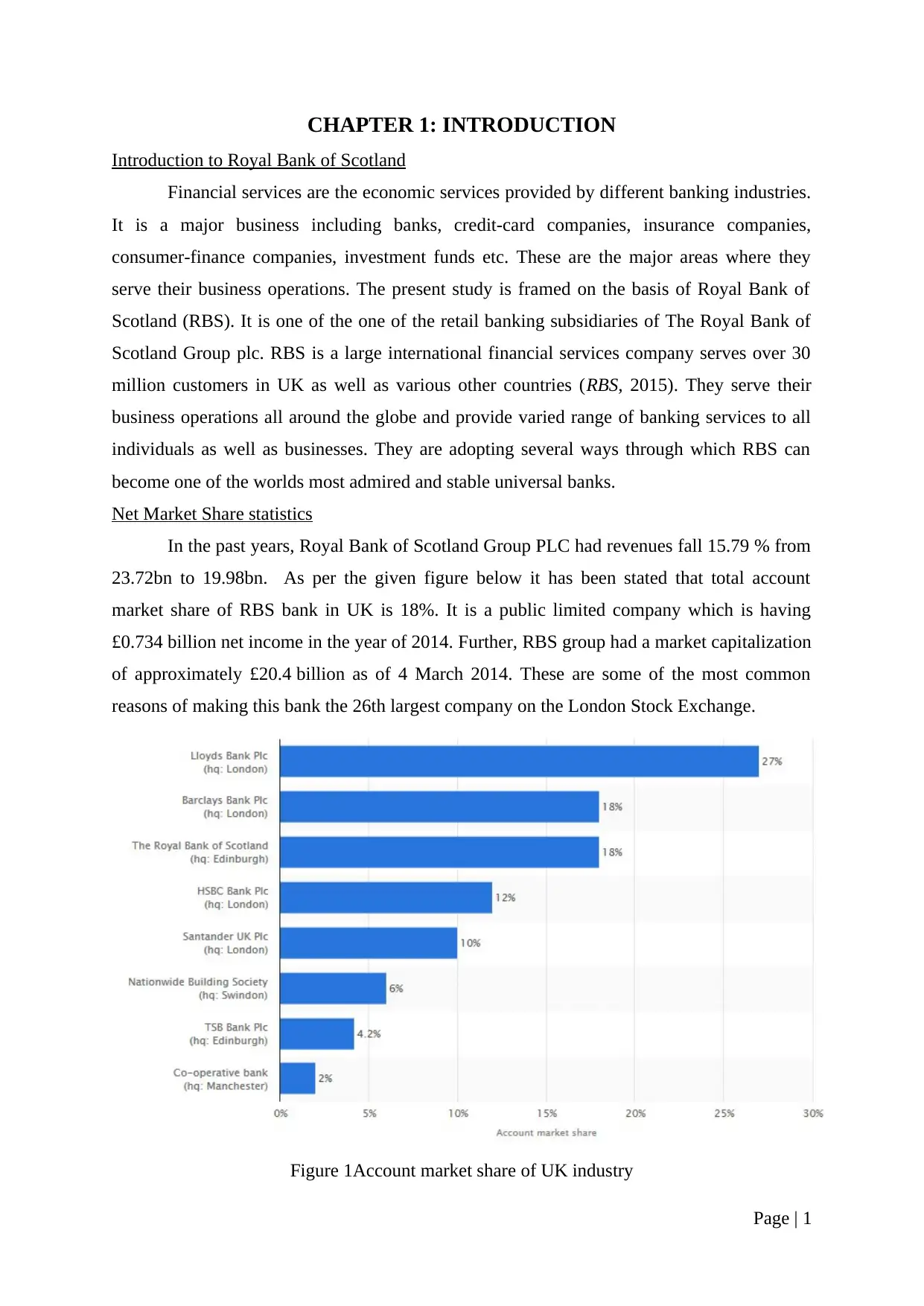
CHAPTER 1: INTRODUCTION
Introduction to Royal Bank of Scotland
Financial services are the economic services provided by different banking industries.
It is a major business including banks, credit-card companies, insurance companies,
consumer-finance companies, investment funds etc. These are the major areas where they
serve their business operations. The present study is framed on the basis of Royal Bank of
Scotland (RBS). It is one of the one of the retail banking subsidiaries of The Royal Bank of
Scotland Group plc. RBS is a large international financial services company serves over 30
million customers in UK as well as various other countries (RBS, 2015). They serve their
business operations all around the globe and provide varied range of banking services to all
individuals as well as businesses. They are adopting several ways through which RBS can
become one of the worlds most admired and stable universal banks.
Net Market Share statistics
In the past years, Royal Bank of Scotland Group PLC had revenues fall 15.79 % from
23.72bn to 19.98bn. As per the given figure below it has been stated that total account
market share of RBS bank in UK is 18%. It is a public limited company which is having
£0.734 billion net income in the year of 2014. Further, RBS group had a market capitalization
of approximately £20.4 billion as of 4 March 2014. These are some of the most common
reasons of making this bank the 26th largest company on the London Stock Exchange.
Figure 1Account market share of UK industry
Page | 1
Introduction to Royal Bank of Scotland
Financial services are the economic services provided by different banking industries.
It is a major business including banks, credit-card companies, insurance companies,
consumer-finance companies, investment funds etc. These are the major areas where they
serve their business operations. The present study is framed on the basis of Royal Bank of
Scotland (RBS). It is one of the one of the retail banking subsidiaries of The Royal Bank of
Scotland Group plc. RBS is a large international financial services company serves over 30
million customers in UK as well as various other countries (RBS, 2015). They serve their
business operations all around the globe and provide varied range of banking services to all
individuals as well as businesses. They are adopting several ways through which RBS can
become one of the worlds most admired and stable universal banks.
Net Market Share statistics
In the past years, Royal Bank of Scotland Group PLC had revenues fall 15.79 % from
23.72bn to 19.98bn. As per the given figure below it has been stated that total account
market share of RBS bank in UK is 18%. It is a public limited company which is having
£0.734 billion net income in the year of 2014. Further, RBS group had a market capitalization
of approximately £20.4 billion as of 4 March 2014. These are some of the most common
reasons of making this bank the 26th largest company on the London Stock Exchange.
Figure 1Account market share of UK industry
Page | 1
Paraphrase This Document
Need a fresh take? Get an instant paraphrase of this document with our AI Paraphraser
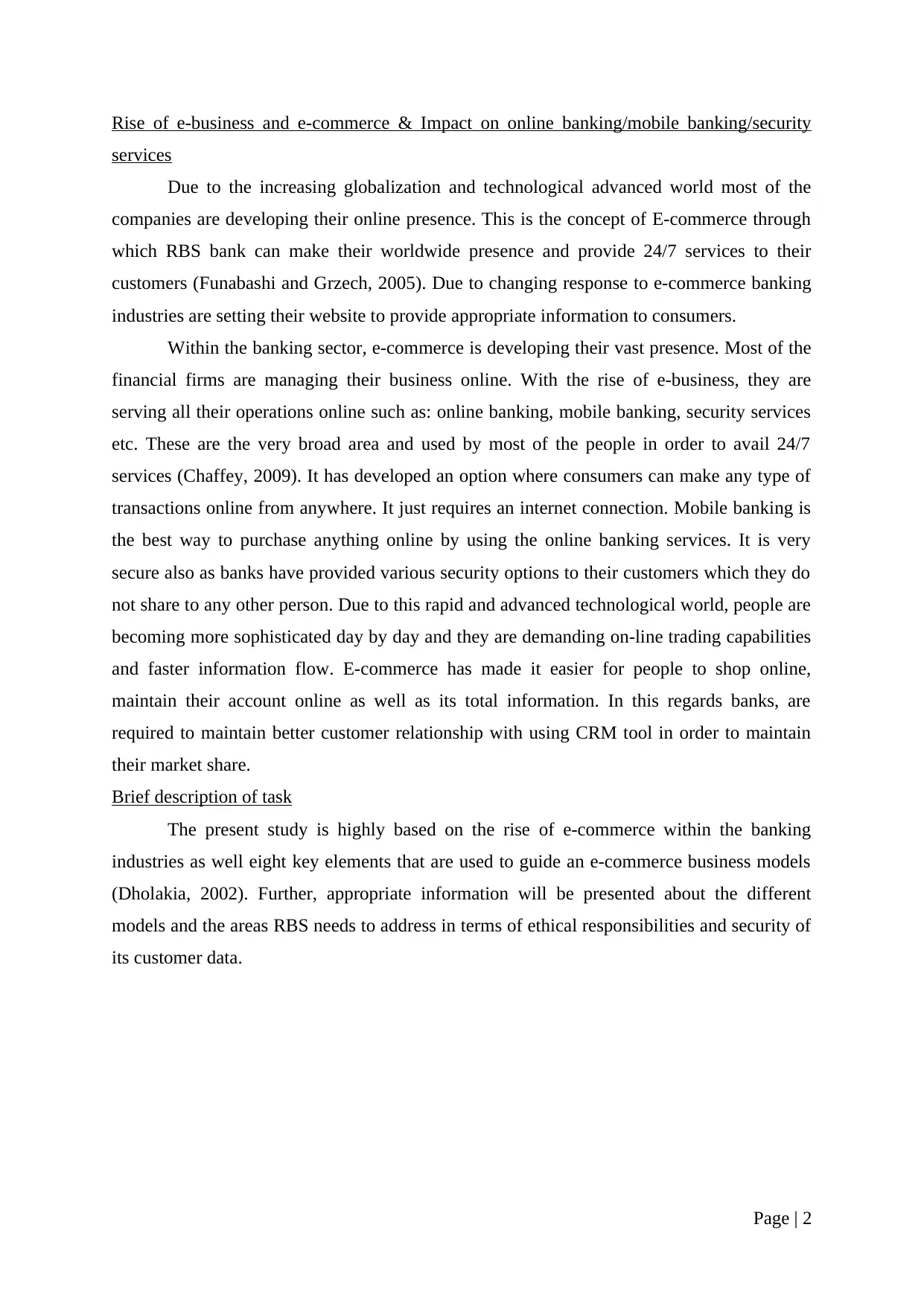
Rise of e-business and e-commerce & Impact on online banking/mobile banking/security
services
Due to the increasing globalization and technological advanced world most of the
companies are developing their online presence. This is the concept of E-commerce through
which RBS bank can make their worldwide presence and provide 24/7 services to their
customers (Funabashi and Grzech, 2005). Due to changing response to e-commerce banking
industries are setting their website to provide appropriate information to consumers.
Within the banking sector, e-commerce is developing their vast presence. Most of the
financial firms are managing their business online. With the rise of e-business, they are
serving all their operations online such as: online banking, mobile banking, security services
etc. These are the very broad area and used by most of the people in order to avail 24/7
services (Chaffey, 2009). It has developed an option where consumers can make any type of
transactions online from anywhere. It just requires an internet connection. Mobile banking is
the best way to purchase anything online by using the online banking services. It is very
secure also as banks have provided various security options to their customers which they do
not share to any other person. Due to this rapid and advanced technological world, people are
becoming more sophisticated day by day and they are demanding on-line trading capabilities
and faster information flow. E-commerce has made it easier for people to shop online,
maintain their account online as well as its total information. In this regards banks, are
required to maintain better customer relationship with using CRM tool in order to maintain
their market share.
Brief description of task
The present study is highly based on the rise of e-commerce within the banking
industries as well eight key elements that are used to guide an e-commerce business models
(Dholakia, 2002). Further, appropriate information will be presented about the different
models and the areas RBS needs to address in terms of ethical responsibilities and security of
its customer data.
Page | 2
services
Due to the increasing globalization and technological advanced world most of the
companies are developing their online presence. This is the concept of E-commerce through
which RBS bank can make their worldwide presence and provide 24/7 services to their
customers (Funabashi and Grzech, 2005). Due to changing response to e-commerce banking
industries are setting their website to provide appropriate information to consumers.
Within the banking sector, e-commerce is developing their vast presence. Most of the
financial firms are managing their business online. With the rise of e-business, they are
serving all their operations online such as: online banking, mobile banking, security services
etc. These are the very broad area and used by most of the people in order to avail 24/7
services (Chaffey, 2009). It has developed an option where consumers can make any type of
transactions online from anywhere. It just requires an internet connection. Mobile banking is
the best way to purchase anything online by using the online banking services. It is very
secure also as banks have provided various security options to their customers which they do
not share to any other person. Due to this rapid and advanced technological world, people are
becoming more sophisticated day by day and they are demanding on-line trading capabilities
and faster information flow. E-commerce has made it easier for people to shop online,
maintain their account online as well as its total information. In this regards banks, are
required to maintain better customer relationship with using CRM tool in order to maintain
their market share.
Brief description of task
The present study is highly based on the rise of e-commerce within the banking
industries as well eight key elements that are used to guide an e-commerce business models
(Dholakia, 2002). Further, appropriate information will be presented about the different
models and the areas RBS needs to address in terms of ethical responsibilities and security of
its customer data.
Page | 2
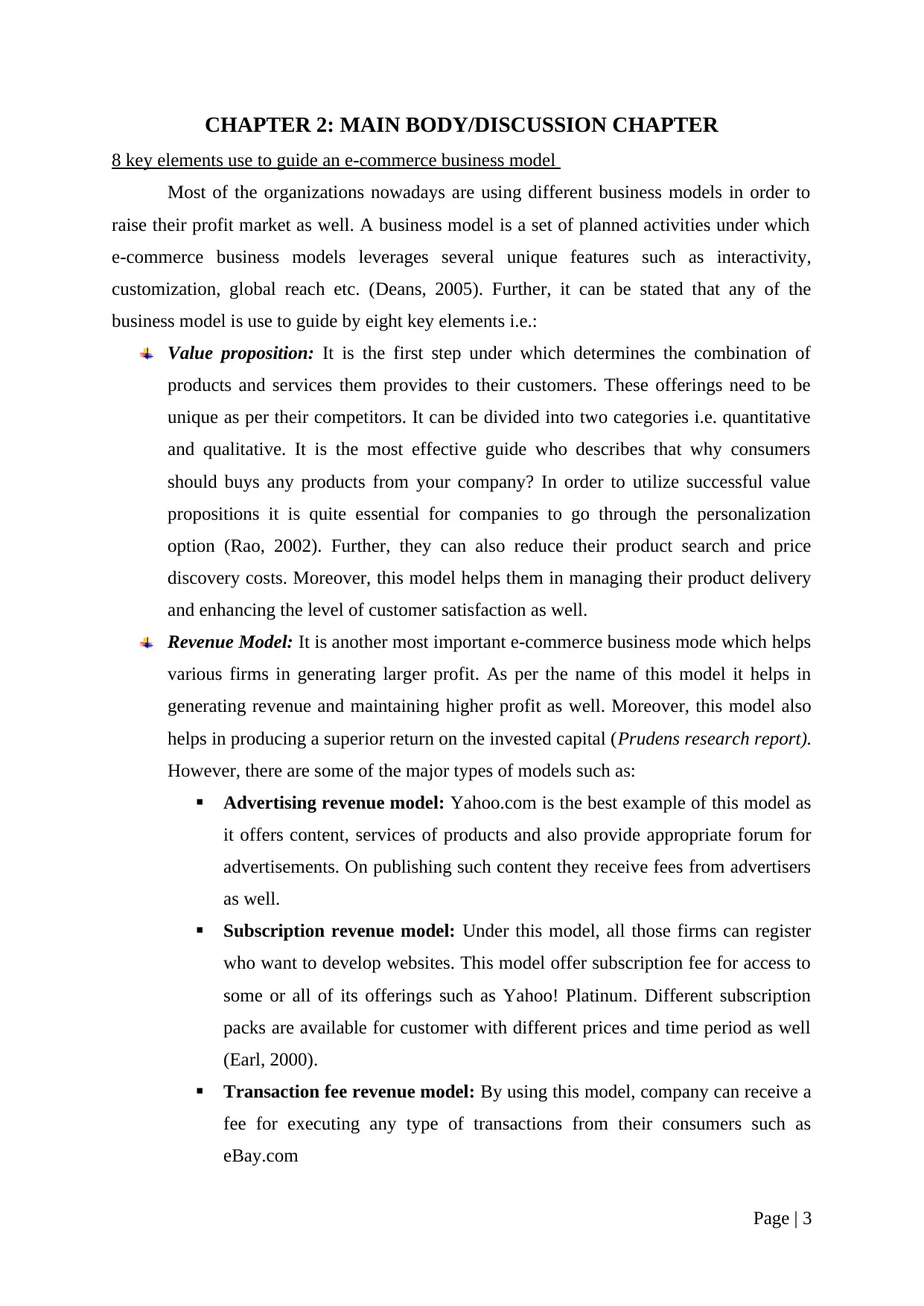
CHAPTER 2: MAIN BODY/DISCUSSION CHAPTER
8 key elements use to guide an e-commerce business model
Most of the organizations nowadays are using different business models in order to
raise their profit market as well. A business model is a set of planned activities under which
e-commerce business models leverages several unique features such as interactivity,
customization, global reach etc. (Deans, 2005). Further, it can be stated that any of the
business model is use to guide by eight key elements i.e.:
Value proposition: It is the first step under which determines the combination of
products and services them provides to their customers. These offerings need to be
unique as per their competitors. It can be divided into two categories i.e. quantitative
and qualitative. It is the most effective guide who describes that why consumers
should buys any products from your company? In order to utilize successful value
propositions it is quite essential for companies to go through the personalization
option (Rao, 2002). Further, they can also reduce their product search and price
discovery costs. Moreover, this model helps them in managing their product delivery
and enhancing the level of customer satisfaction as well.
Revenue Model: It is another most important e-commerce business mode which helps
various firms in generating larger profit. As per the name of this model it helps in
generating revenue and maintaining higher profit as well. Moreover, this model also
helps in producing a superior return on the invested capital (Prudens research report).
However, there are some of the major types of models such as:
Advertising revenue model: Yahoo.com is the best example of this model as
it offers content, services of products and also provide appropriate forum for
advertisements. On publishing such content they receive fees from advertisers
as well.
Subscription revenue model: Under this model, all those firms can register
who want to develop websites. This model offer subscription fee for access to
some or all of its offerings such as Yahoo! Platinum. Different subscription
packs are available for customer with different prices and time period as well
(Earl, 2000).
Transaction fee revenue model: By using this model, company can receive a
fee for executing any type of transactions from their consumers such as
eBay.com
Page | 3
8 key elements use to guide an e-commerce business model
Most of the organizations nowadays are using different business models in order to
raise their profit market as well. A business model is a set of planned activities under which
e-commerce business models leverages several unique features such as interactivity,
customization, global reach etc. (Deans, 2005). Further, it can be stated that any of the
business model is use to guide by eight key elements i.e.:
Value proposition: It is the first step under which determines the combination of
products and services them provides to their customers. These offerings need to be
unique as per their competitors. It can be divided into two categories i.e. quantitative
and qualitative. It is the most effective guide who describes that why consumers
should buys any products from your company? In order to utilize successful value
propositions it is quite essential for companies to go through the personalization
option (Rao, 2002). Further, they can also reduce their product search and price
discovery costs. Moreover, this model helps them in managing their product delivery
and enhancing the level of customer satisfaction as well.
Revenue Model: It is another most important e-commerce business mode which helps
various firms in generating larger profit. As per the name of this model it helps in
generating revenue and maintaining higher profit as well. Moreover, this model also
helps in producing a superior return on the invested capital (Prudens research report).
However, there are some of the major types of models such as:
Advertising revenue model: Yahoo.com is the best example of this model as
it offers content, services of products and also provide appropriate forum for
advertisements. On publishing such content they receive fees from advertisers
as well.
Subscription revenue model: Under this model, all those firms can register
who want to develop websites. This model offer subscription fee for access to
some or all of its offerings such as Yahoo! Platinum. Different subscription
packs are available for customer with different prices and time period as well
(Earl, 2000).
Transaction fee revenue model: By using this model, company can receive a
fee for executing any type of transactions from their consumers such as
eBay.com
Page | 3
⊘ This is a preview!⊘
Do you want full access?
Subscribe today to unlock all pages.

Trusted by 1+ million students worldwide

Sales revenue model: Amazon is the highly used site and they worked with
the sales revenue model. In this they derived higher revenues by selling goods,
information or services to their customers.
Affiliate revenue model: These are the websites that steer business to an
“affiliate” and also receives a referral fee (Plant, 2000).
These are some of the most common models used by different organizations in order
to attain higher profit and revenue as well.
Market opportunity: This is another type of business model’s key element through
which firm can decide the realistic market opportunities as well as market space. They
are able to identify the intended market they want to serve and what is its size?
Competitive environment: After selecting the market space firm can identify all its
competitors and other companies selling similar market within the same market. It is
the best way to determine their future market growth by both direct and indirect
competitors as well (Morteza, 2011). In this way, this stage is influenced by the
competitor’s profitability, pricing as well as number and size of active competitors
within the market.
Competitive advantage: Here, the form can identify all the special advantages they
can bring to the selected marketplace. It defines that is company’s product is superior
to or cheaper to produce than the competitors.
Market strategy: It is another most effective way under which companies can set a
plan to promote their products and services and attract all their target audience as
well. In addition to this, company can set out details to enter into market and best
business concepts to sell their products.
Organizational development: At this element of business model firm can set the
business model that is necessary to carry out the business plan. Moreover, they can
decide that how they can carry out their work in a more effective and appropriate way
(Louvieris, Westering and Driver, 2003). The whole development describes that how
firm will organize their work such as: they can typically divide into functional
departments and hire generalist’s to specialists.
Management team: This is the last and most important key element company must
decide. They require selecting that what kind of experience and background should
the company’s leaders have. Further, it can be stated that a strong management team
can make the business mode works and has experience in implementing business
plans (Jengchung and et.al, 2013).
Page | 4
the sales revenue model. In this they derived higher revenues by selling goods,
information or services to their customers.
Affiliate revenue model: These are the websites that steer business to an
“affiliate” and also receives a referral fee (Plant, 2000).
These are some of the most common models used by different organizations in order
to attain higher profit and revenue as well.
Market opportunity: This is another type of business model’s key element through
which firm can decide the realistic market opportunities as well as market space. They
are able to identify the intended market they want to serve and what is its size?
Competitive environment: After selecting the market space firm can identify all its
competitors and other companies selling similar market within the same market. It is
the best way to determine their future market growth by both direct and indirect
competitors as well (Morteza, 2011). In this way, this stage is influenced by the
competitor’s profitability, pricing as well as number and size of active competitors
within the market.
Competitive advantage: Here, the form can identify all the special advantages they
can bring to the selected marketplace. It defines that is company’s product is superior
to or cheaper to produce than the competitors.
Market strategy: It is another most effective way under which companies can set a
plan to promote their products and services and attract all their target audience as
well. In addition to this, company can set out details to enter into market and best
business concepts to sell their products.
Organizational development: At this element of business model firm can set the
business model that is necessary to carry out the business plan. Moreover, they can
decide that how they can carry out their work in a more effective and appropriate way
(Louvieris, Westering and Driver, 2003). The whole development describes that how
firm will organize their work such as: they can typically divide into functional
departments and hire generalist’s to specialists.
Management team: This is the last and most important key element company must
decide. They require selecting that what kind of experience and background should
the company’s leaders have. Further, it can be stated that a strong management team
can make the business mode works and has experience in implementing business
plans (Jengchung and et.al, 2013).
Page | 4
Paraphrase This Document
Need a fresh take? Get an instant paraphrase of this document with our AI Paraphraser

Business module for Royal Scotland bank (RBS)
In order to develop online presence most of the companies are adopting some of the
best business models. Some of the most common e-business models used by Royal Scotland
bank are:
B2B: It is concept of business to business selling where companies are having their
private industrial network. RBS is a public owned firm and they are having their different
branches within different area of field. With the help of this model RBS bank can offer
appropriate data management as well as in depth analysis and interactive marketing solutions
to help build business decisions (LI, 2007). Further, Exchanges B2B models are used by them
through which suppliers and purchasers conduct transactions. In addition to this, transaction,
commission fees revenue model used under this which creates powerful competition between
suppliers.
B2C: It is concept of business to consumer which is used by RBS bank in order to
provide them online banking and mobile banking option (Chaffey, 2009). Here, with this
model they can distribute all types of services over the internet and customers can directly
make use of it. For all the customers it is relatively easy to appreciate the importance of e-
commerce. Further, RBS use this model in order to provide regular online banking services to
their customers. There are different B2C models such as Market creator, portal, content
provider, transaction broker etc. In this entire model, RBS uses transaction broker model
which process online transaction for consumers (Manzoor, 2010).
Figure 2B2B vs. B2C E-Commerce
(Source: Prudens research report, n.d.)
Page | 5
In order to develop online presence most of the companies are adopting some of the
best business models. Some of the most common e-business models used by Royal Scotland
bank are:
B2B: It is concept of business to business selling where companies are having their
private industrial network. RBS is a public owned firm and they are having their different
branches within different area of field. With the help of this model RBS bank can offer
appropriate data management as well as in depth analysis and interactive marketing solutions
to help build business decisions (LI, 2007). Further, Exchanges B2B models are used by them
through which suppliers and purchasers conduct transactions. In addition to this, transaction,
commission fees revenue model used under this which creates powerful competition between
suppliers.
B2C: It is concept of business to consumer which is used by RBS bank in order to
provide them online banking and mobile banking option (Chaffey, 2009). Here, with this
model they can distribute all types of services over the internet and customers can directly
make use of it. For all the customers it is relatively easy to appreciate the importance of e-
commerce. Further, RBS use this model in order to provide regular online banking services to
their customers. There are different B2C models such as Market creator, portal, content
provider, transaction broker etc. In this entire model, RBS uses transaction broker model
which process online transaction for consumers (Manzoor, 2010).
Figure 2B2B vs. B2C E-Commerce
(Source: Prudens research report, n.d.)
Page | 5
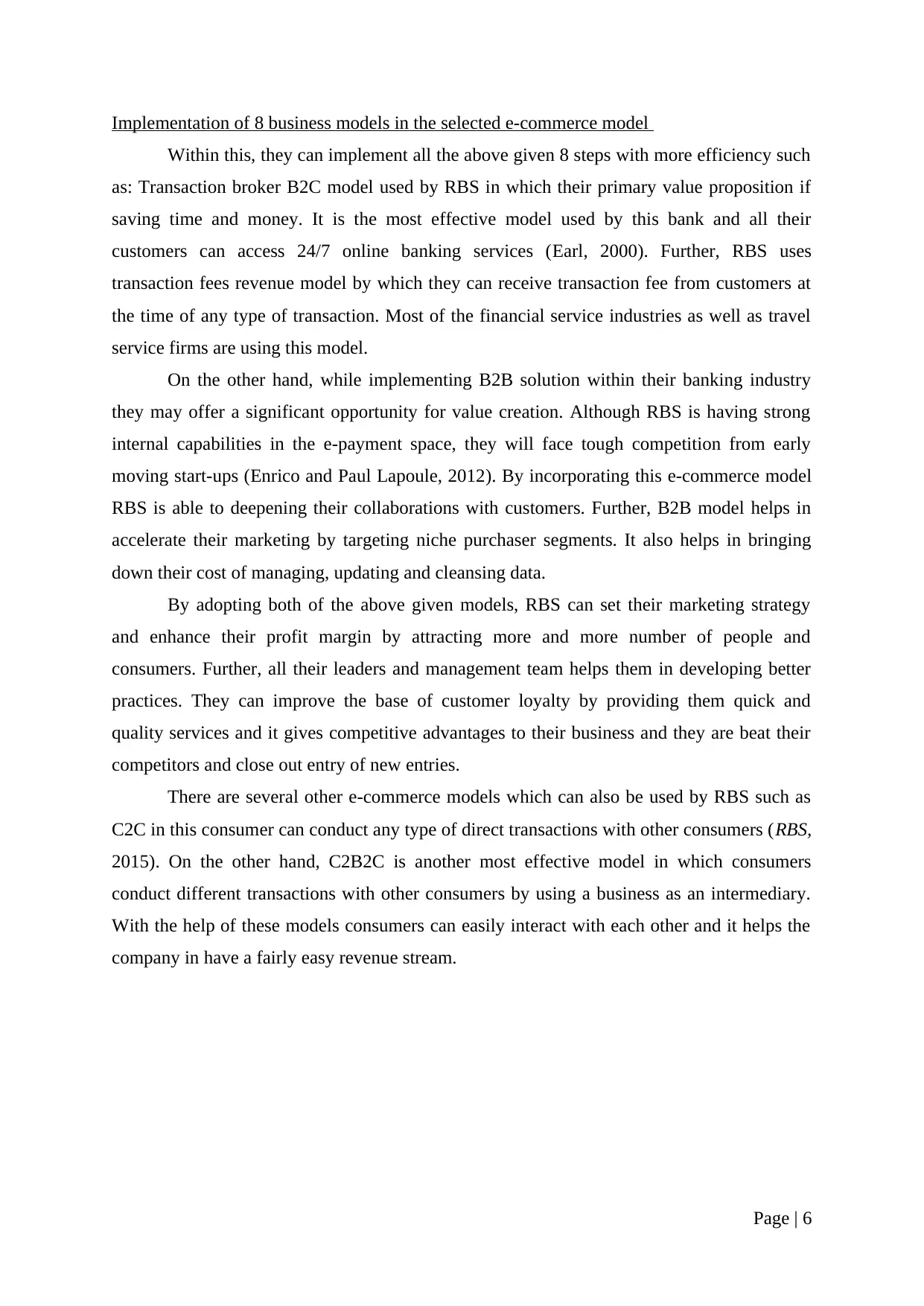
Implementation of 8 business models in the selected e-commerce model
Within this, they can implement all the above given 8 steps with more efficiency such
as: Transaction broker B2C model used by RBS in which their primary value proposition if
saving time and money. It is the most effective model used by this bank and all their
customers can access 24/7 online banking services (Earl, 2000). Further, RBS uses
transaction fees revenue model by which they can receive transaction fee from customers at
the time of any type of transaction. Most of the financial service industries as well as travel
service firms are using this model.
On the other hand, while implementing B2B solution within their banking industry
they may offer a significant opportunity for value creation. Although RBS is having strong
internal capabilities in the e-payment space, they will face tough competition from early
moving start-ups (Enrico and Paul Lapoule, 2012). By incorporating this e-commerce model
RBS is able to deepening their collaborations with customers. Further, B2B model helps in
accelerate their marketing by targeting niche purchaser segments. It also helps in bringing
down their cost of managing, updating and cleansing data.
By adopting both of the above given models, RBS can set their marketing strategy
and enhance their profit margin by attracting more and more number of people and
consumers. Further, all their leaders and management team helps them in developing better
practices. They can improve the base of customer loyalty by providing them quick and
quality services and it gives competitive advantages to their business and they are beat their
competitors and close out entry of new entries.
There are several other e-commerce models which can also be used by RBS such as
C2C in this consumer can conduct any type of direct transactions with other consumers (RBS,
2015). On the other hand, C2B2C is another most effective model in which consumers
conduct different transactions with other consumers by using a business as an intermediary.
With the help of these models consumers can easily interact with each other and it helps the
company in have a fairly easy revenue stream.
Page | 6
Within this, they can implement all the above given 8 steps with more efficiency such
as: Transaction broker B2C model used by RBS in which their primary value proposition if
saving time and money. It is the most effective model used by this bank and all their
customers can access 24/7 online banking services (Earl, 2000). Further, RBS uses
transaction fees revenue model by which they can receive transaction fee from customers at
the time of any type of transaction. Most of the financial service industries as well as travel
service firms are using this model.
On the other hand, while implementing B2B solution within their banking industry
they may offer a significant opportunity for value creation. Although RBS is having strong
internal capabilities in the e-payment space, they will face tough competition from early
moving start-ups (Enrico and Paul Lapoule, 2012). By incorporating this e-commerce model
RBS is able to deepening their collaborations with customers. Further, B2B model helps in
accelerate their marketing by targeting niche purchaser segments. It also helps in bringing
down their cost of managing, updating and cleansing data.
By adopting both of the above given models, RBS can set their marketing strategy
and enhance their profit margin by attracting more and more number of people and
consumers. Further, all their leaders and management team helps them in developing better
practices. They can improve the base of customer loyalty by providing them quick and
quality services and it gives competitive advantages to their business and they are beat their
competitors and close out entry of new entries.
There are several other e-commerce models which can also be used by RBS such as
C2C in this consumer can conduct any type of direct transactions with other consumers (RBS,
2015). On the other hand, C2B2C is another most effective model in which consumers
conduct different transactions with other consumers by using a business as an intermediary.
With the help of these models consumers can easily interact with each other and it helps the
company in have a fairly easy revenue stream.
Page | 6
⊘ This is a preview!⊘
Do you want full access?
Subscribe today to unlock all pages.

Trusted by 1+ million students worldwide
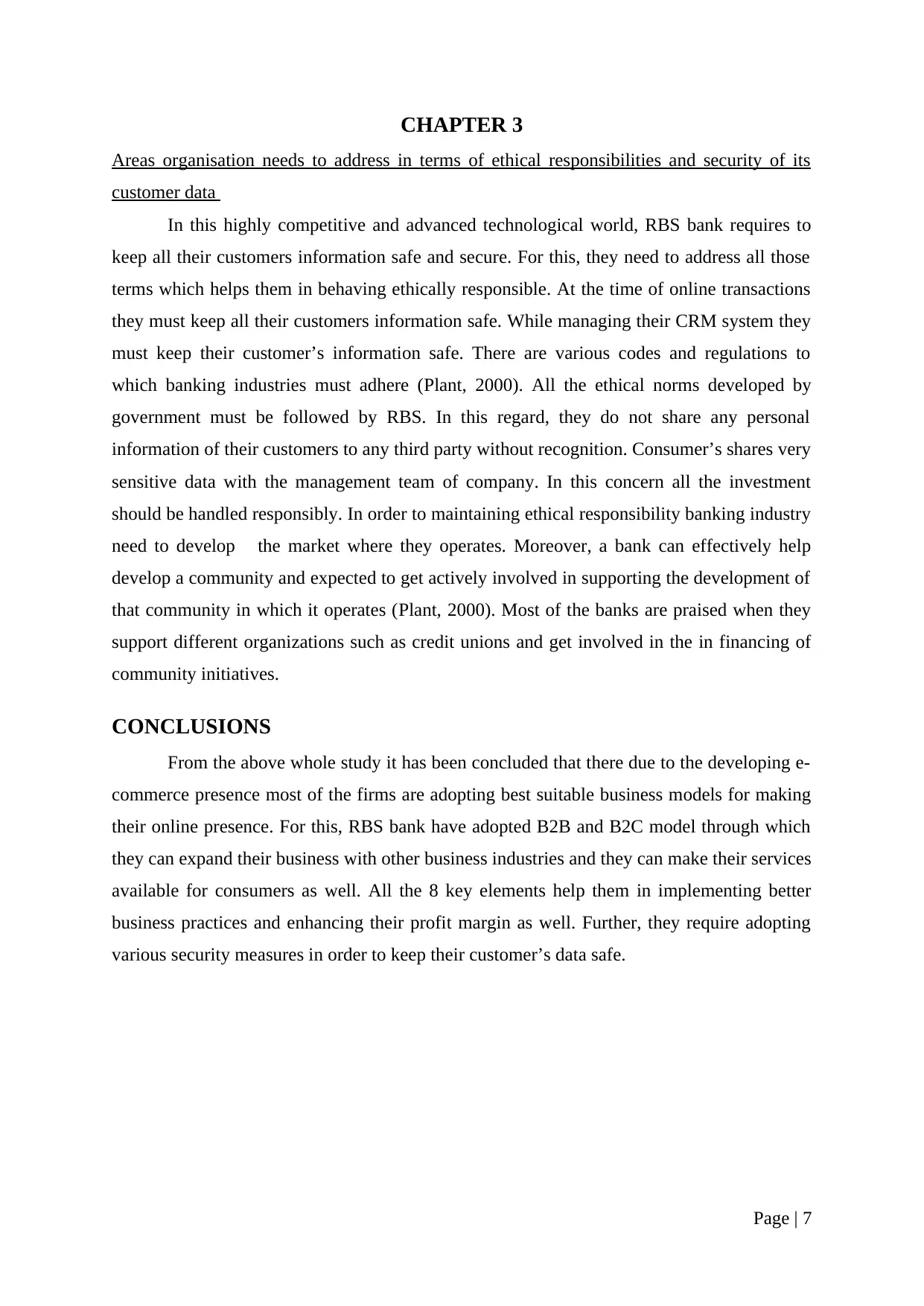
CHAPTER 3
Areas organisation needs to address in terms of ethical responsibilities and security of its
customer data
In this highly competitive and advanced technological world, RBS bank requires to
keep all their customers information safe and secure. For this, they need to address all those
terms which helps them in behaving ethically responsible. At the time of online transactions
they must keep all their customers information safe. While managing their CRM system they
must keep their customer’s information safe. There are various codes and regulations to
which banking industries must adhere (Plant, 2000). All the ethical norms developed by
government must be followed by RBS. In this regard, they do not share any personal
information of their customers to any third party without recognition. Consumer’s shares very
sensitive data with the management team of company. In this concern all the investment
should be handled responsibly. In order to maintaining ethical responsibility banking industry
need to develop the market where they operates. Moreover, a bank can effectively help
develop a community and expected to get actively involved in supporting the development of
that community in which it operates (Plant, 2000). Most of the banks are praised when they
support different organizations such as credit unions and get involved in the in financing of
community initiatives.
CONCLUSIONS
From the above whole study it has been concluded that there due to the developing e-
commerce presence most of the firms are adopting best suitable business models for making
their online presence. For this, RBS bank have adopted B2B and B2C model through which
they can expand their business with other business industries and they can make their services
available for consumers as well. All the 8 key elements help them in implementing better
business practices and enhancing their profit margin as well. Further, they require adopting
various security measures in order to keep their customer’s data safe.
Page | 7
Areas organisation needs to address in terms of ethical responsibilities and security of its
customer data
In this highly competitive and advanced technological world, RBS bank requires to
keep all their customers information safe and secure. For this, they need to address all those
terms which helps them in behaving ethically responsible. At the time of online transactions
they must keep all their customers information safe. While managing their CRM system they
must keep their customer’s information safe. There are various codes and regulations to
which banking industries must adhere (Plant, 2000). All the ethical norms developed by
government must be followed by RBS. In this regard, they do not share any personal
information of their customers to any third party without recognition. Consumer’s shares very
sensitive data with the management team of company. In this concern all the investment
should be handled responsibly. In order to maintaining ethical responsibility banking industry
need to develop the market where they operates. Moreover, a bank can effectively help
develop a community and expected to get actively involved in supporting the development of
that community in which it operates (Plant, 2000). Most of the banks are praised when they
support different organizations such as credit unions and get involved in the in financing of
community initiatives.
CONCLUSIONS
From the above whole study it has been concluded that there due to the developing e-
commerce presence most of the firms are adopting best suitable business models for making
their online presence. For this, RBS bank have adopted B2B and B2C model through which
they can expand their business with other business industries and they can make their services
available for consumers as well. All the 8 key elements help them in implementing better
business practices and enhancing their profit margin as well. Further, they require adopting
various security measures in order to keep their customer’s data safe.
Page | 7
Paraphrase This Document
Need a fresh take? Get an instant paraphrase of this document with our AI Paraphraser
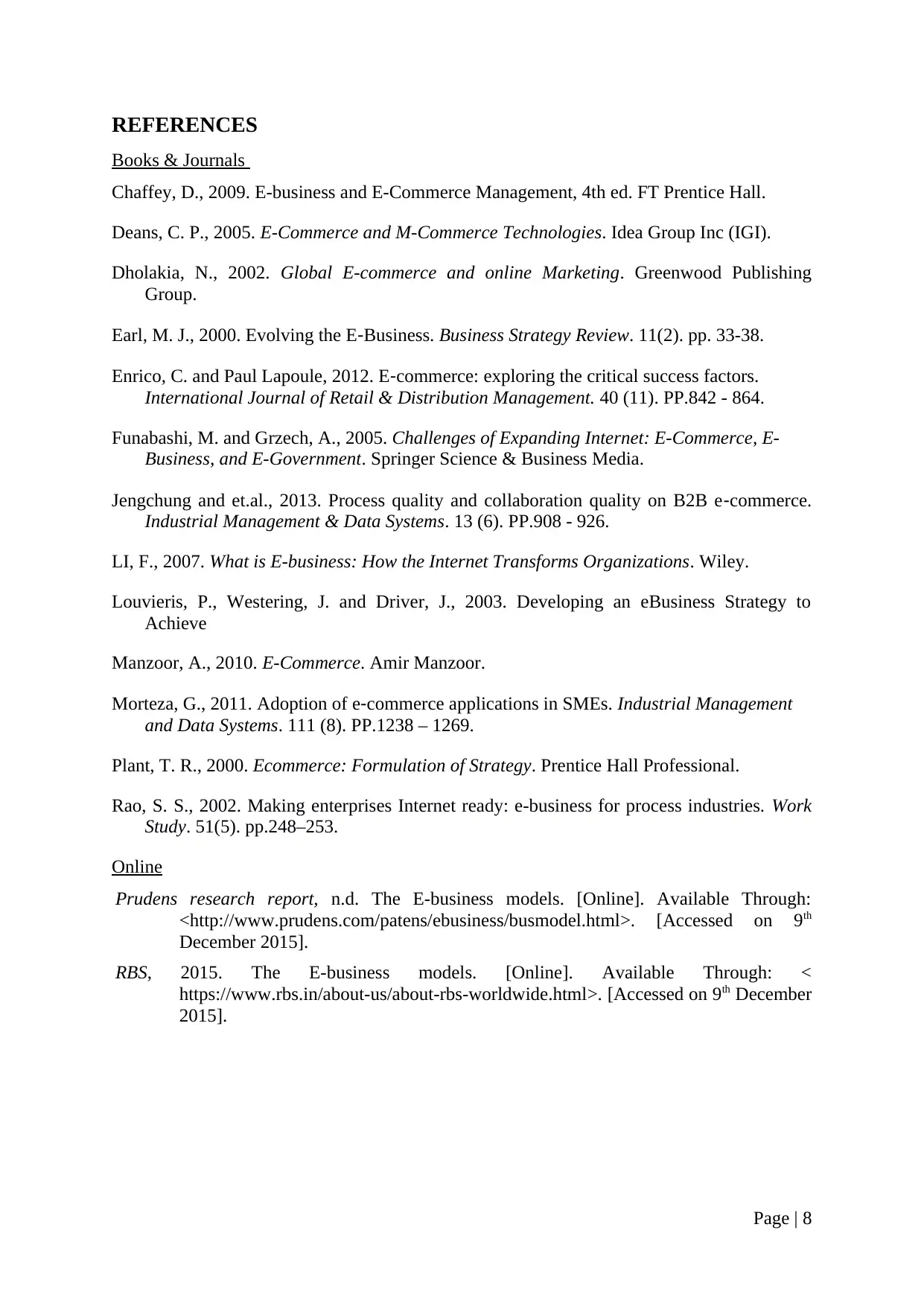
REFERENCES
Books & Journals
Chaffey, D., 2009. E-business and E-Commerce Management, 4th ed. FT Prentice Hall.
Deans, C. P., 2005. E-Commerce and M-Commerce Technologies. Idea Group Inc (IGI).
Dholakia, N., 2002. Global E-commerce and online Marketing. Greenwood Publishing
Group.
Earl, M. J., 2000. Evolving the E‐Business. Business Strategy Review. 11(2). pp. 33-38.
Enrico, C. and Paul Lapoule, 2012. E‐commerce: exploring the critical success factors.
International Journal of Retail & Distribution Management. 40 (11). PP.842 - 864.
Funabashi, M. and Grzech, A., 2005. Challenges of Expanding Internet: E-Commerce, E-
Business, and E-Government. Springer Science & Business Media.
Jengchung and et.al., 2013. Process quality and collaboration quality on B2B e‐commerce.
Industrial Management & Data Systems. 13 (6). PP.908 - 926.
LI, F., 2007. What is E-business: How the Internet Transforms Organizations. Wiley.
Louvieris, P., Westering, J. and Driver, J., 2003. Developing an eBusiness Strategy to
Achieve
Manzoor, A., 2010. E-Commerce. Amir Manzoor.
Morteza, G., 2011. Adoption of e‐commerce applications in SMEs. Industrial Management
and Data Systems. 111 (8). PP.1238 – 1269.
Plant, T. R., 2000. Ecommerce: Formulation of Strategy. Prentice Hall Professional.
Rao, S. S., 2002. Making enterprises Internet ready: e-business for process industries. Work
Study. 51(5). pp.248–253.
Online
Prudens research report, n.d. The E-business models. [Online]. Available Through:
<http://www.prudens.com/patens/ebusiness/busmodel.html>. [Accessed on 9th
December 2015].
RBS, 2015. The E-business models. [Online]. Available Through: <
https://www.rbs.in/about-us/about-rbs-worldwide.html>. [Accessed on 9th December
2015].
Page | 8
Books & Journals
Chaffey, D., 2009. E-business and E-Commerce Management, 4th ed. FT Prentice Hall.
Deans, C. P., 2005. E-Commerce and M-Commerce Technologies. Idea Group Inc (IGI).
Dholakia, N., 2002. Global E-commerce and online Marketing. Greenwood Publishing
Group.
Earl, M. J., 2000. Evolving the E‐Business. Business Strategy Review. 11(2). pp. 33-38.
Enrico, C. and Paul Lapoule, 2012. E‐commerce: exploring the critical success factors.
International Journal of Retail & Distribution Management. 40 (11). PP.842 - 864.
Funabashi, M. and Grzech, A., 2005. Challenges of Expanding Internet: E-Commerce, E-
Business, and E-Government. Springer Science & Business Media.
Jengchung and et.al., 2013. Process quality and collaboration quality on B2B e‐commerce.
Industrial Management & Data Systems. 13 (6). PP.908 - 926.
LI, F., 2007. What is E-business: How the Internet Transforms Organizations. Wiley.
Louvieris, P., Westering, J. and Driver, J., 2003. Developing an eBusiness Strategy to
Achieve
Manzoor, A., 2010. E-Commerce. Amir Manzoor.
Morteza, G., 2011. Adoption of e‐commerce applications in SMEs. Industrial Management
and Data Systems. 111 (8). PP.1238 – 1269.
Plant, T. R., 2000. Ecommerce: Formulation of Strategy. Prentice Hall Professional.
Rao, S. S., 2002. Making enterprises Internet ready: e-business for process industries. Work
Study. 51(5). pp.248–253.
Online
Prudens research report, n.d. The E-business models. [Online]. Available Through:
<http://www.prudens.com/patens/ebusiness/busmodel.html>. [Accessed on 9th
December 2015].
RBS, 2015. The E-business models. [Online]. Available Through: <
https://www.rbs.in/about-us/about-rbs-worldwide.html>. [Accessed on 9th December
2015].
Page | 8
1 out of 11
Related Documents
Your All-in-One AI-Powered Toolkit for Academic Success.
+13062052269
info@desklib.com
Available 24*7 on WhatsApp / Email
![[object Object]](/_next/static/media/star-bottom.7253800d.svg)
Unlock your academic potential
Copyright © 2020–2025 A2Z Services. All Rights Reserved. Developed and managed by ZUCOL.




